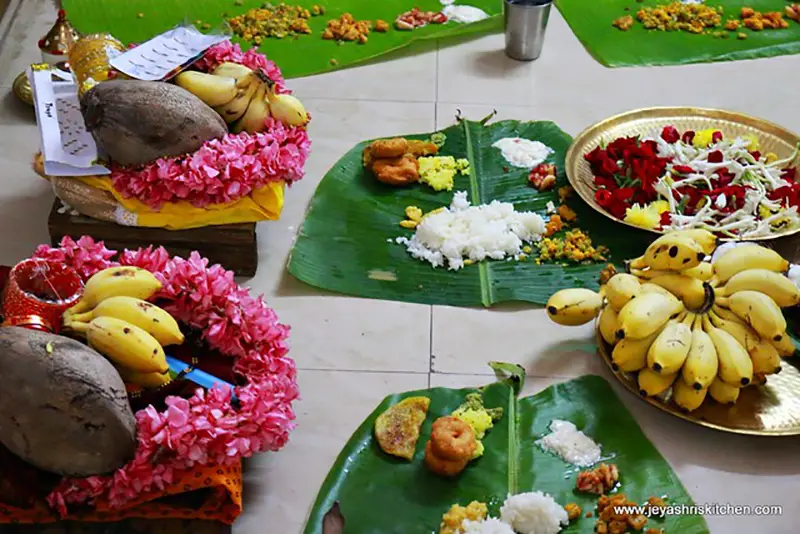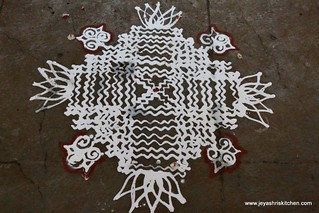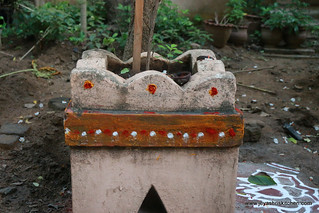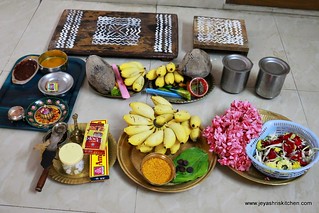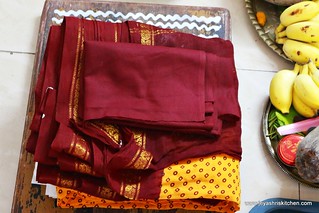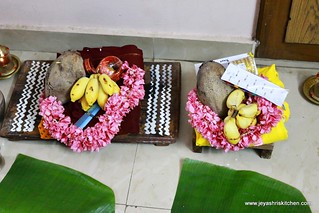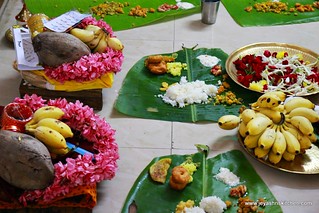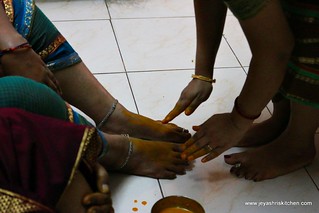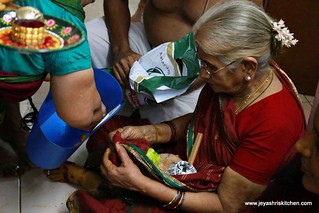Sumangali Prarthanai is made in many families every year in remembrance of the ladies who passed away in the family as sumangali. Sumangali is nothing but a married women whose husband is alive and if she passes away before her husband she is considered as blessed in Brahmin Tradition. Generally we do sumangali prarthanai before wedding, poonal ,seemandham or grahapravsesham too. Sometimes they pray to the ancestors and wish for anything and do this also. If we didn’t have any occasion at home for 3-4 years, we just casually do this sumangali prarthanai just to seek the blessings for the entire family. That’s why this time we did at our home. Generally 5or 7 sumangalis and 2 Kanya Kids(girls who didn’t attain puberty) will be invited for the pooja. As such no elaborate pooja will there for this function. But unlike other functions, this is completely a ladies function and the pondugals who are invited along with the kanyas will be served the food first. Generally if a daughter is getting married in the girl’s side they will do it compulsorily before the wedding and keeping the daughter who is going to get married as one of the pondugal. But in the boy’s house also they do the sumangali prarthanai but they can either do it before the wedding with their family members or they can either do it once the daughter in law comes into the house. But a daughter in law cannot be a pondugal. since we are the host, we cannot sit as pondugal. But i have seen in few families, according to their tradition, they keep daughter-in law also as one of the pondugal. But generally it is not the case. Generally this cannot be performed twice a year. Only once a year only we can do this. That too if there are 3 brothers in the family, if one brother is performing this year as he wish to do, generally for the whole year rest of the brothers should not perform the pooja though they have any poonal or seemandhan . It is considered as the blessings will continue to be there the entire year. Also the daughters of the family are generally invited as pondugals. But they don’t have daughter, we can always call people from our relative circle, who are not our Pangalis. Any Sumangali is eligible to sit for pondugal provided she should not have periods , not even 4th day is allowed. Also if anyone in the pondugal’s family passed away and still the Varushaptigam is not done, she is not eligible to come. Coming to the procedure, we make a list of mamis to invite and the kanya girls too. Mostly all of them will be ready to come as this is considered as a blessed opportunity. But sometimes there may be some emergencies or last minute drop out too, so we always keep someone in reserve to compensate this. The before day we go and give turmeric, sesame oil , shikakai and mehandhi (marudhani) to the ladies who are invited for pondugal. The tradition is they have to apply mehendi and take oil bath and also apply turmeric while taking bath which is considered very auspicious. They will come home the next day by taking oil bath and wear a 9 yards madi sari (the saree will be washed and dried up inside the house and once it is dried we are not supposed to touch them with hands) Generally we have ropes tied on the top near the sealing and the madi thunis will be put for drying using a stick. It is a technique that comes by practise and my mother in law is an expert in that. I can do small things like towels, a blouse and all but saree is tough for me. So the pondugal will wear the madi pudavai and come to the host’s house. Sometimes if they are coming from nearby towns, they will come and take bath at our house only. In that case, since it is planned in advance, they will bring their own madi blouse and we will prepare a madi saree for her and keep it ready. This time most of the pondugal invited are from my native place in North Arcot district. So they all came around 7 in the morning and took a bath at our place. We kept the sarees for all of them and they all are ready by 9 am. Generally, they are not supposed to eat any solid food before the pooja. So only coffee will be given. If needed one more round of coffee or tea can be given. Even the host also is not supposed to eat any solid food. We put big Maa kolams in front of the house and also tie maa ilai thoranam. Since we have a Thulasi maadam at home, we put kolam in front of that too and decorated that with kumkum . We invite the pondugal by giving manjal, kumkumam to them and giving flowers to keep in their hair. The Sumangali prarthanai is not performed on Tuesdays and Saturdays. Also, The Tamil month of Aadi and Margazhi is not auspicious to do this function. Also ashtami, navami, pradamai, amavasai and pournami are not considered auspicious to do. Any Muhurtham day will be very good and also the good time to do this pooja on the day is also fixed in advanced. Raghu kalam and emagandam are not good and so a good time will be seen considering these factors. The function doesn’t have any elaborate procedure. Once the cooking is over and the time which is fixed in advance as auspicious neivedhyam will be done and we will start serving the food. Before we serve the food we need to prepare for the swami ilai. Among all the pondugals one of them generally who is very senior, will be given the 9 yards saree which we keep in the pooja. That too the saree along with the blouse bit will be soaked in water, early in the morning and kept for drying on the terrace before the pooja it will get dried and we fold this and keep it. The rest of them will be given normal 6yards saree or a simple blouse piece according to their capacity. Both my mom and mil always give saree for all the pondugals. Preparing the place to make pooja: We put 2 small kolams nearer and place two manaiplagais on this and put maa kolam on this. when it is completely dry, fold the saree and place it along with the blouse on the manai palagai. the nuni side of the saree should be kept facing North direction. The dress of the kanya girl is also kept on the second manai palagai. The vethalai, paaku, manjal, poo, small mirror, comb, and bangles all should be kept on both the dress. A small garland(maalai) is also tied around it. We also put our jewellery like chain or necklace and bangle on the pudadavi . Two banana leaves are put in front of the manai and we call them swami ilai. The leaves will be nicely washed and pat dried. Also, all the banana leaves will be put for the pondugal and kanya kid too. All the pondugal will be invited formally and asked to sit in front of the banana leaf. In my mom’s side they all will be standing out of the house and all the ladies in the host’s family will be calling the name of the ancestors who passed away Sumangali and invite the pondugal. The tradition behind this is the pondugal who are invited are considered as our ancestors. My inlaws house they don’t have this tradition. They just formally call all of them and come to sit and tell them to relaxedly sit and have the food. All the food before serving will be served on the pudavai ilai first and then to the all the pondugal . So all the first-time serving will start from the Pudavai ilai. The menu will start with Paruppu payasam, sweet pachadi, thayir pachadi, Kosumalli, raw banana curry, paruppu usili, thogayal, paruppu vadai, poli, variety rice(coconut rice|lemon rice|puliyodarai) , plain rice, poosanikkai pitlai, Kalyana rasam, Thani kootu ,yogurt and ghee. We also make neer mor and panagam too. A mix of sukku podi and jaggery also will be kept, which is given to all after eating to enhance digestion. Once the food is served, the elder sumangali lady in the family, either the mother-in-law or the elder daughter in law will do neivedhyam and show karpooram to the pudavai ilai and all the people from the host’s family will put flowers on the pudavai ilai and do namaskarams to that. Generally while putting flowers elders will tell us to pray for a wish to happen and then do it. It is strongly believed that the wishes made during this time will be fulfilled. Later the food served on the pudavai ilai will be shared among the ladies in the host’s house (that is by me, my co sisters and my mother in law). Once the pondugal will heartily finish the food, we will clean the place. Generally the hosts are supposed to clean the place and not to be done by maid servants. Once they finish the food and come they are asked to sit on the floor in a mat. We have to apply turmeric and nalangu manjal for all of them. They will be given sukku vellam, panagam and Neer mor. Manjal kumkumam along with the vethalai, paaku, kannadi, seepu,poo, saree or blouse piece, a coin will be given to all of them. They won’t take it in the hands instead will get this in their saree thalappu. All the family members including elders will do namaskaram to the Pondugal and the kanya kids. They will put the Akshadai (holy yellow rice) bless the family heartily. The lady who is given the saree which is kept in the pudavai ilai will generally wear the saree before she leaves home. Though the procedure may look elaborate, this is a half a day procedure. Now a days we put cook who will come and cook for this special occasion. So they will take care of the cutting the veggies till cooking, even some of them will serve and clean the kitchen after all work is done and go. This time in December 2014 we had Sumangali prarthanai at my mil’s place and it was a very memorable event and had a great time with all relatives too. I thoroughly enjoyed writing this elaborate post. Thank you so much for reading this patiently.
- Pregnant sumangalis are not generally considered as pondugals.2. Once the oil and shikakai are given to the sumangalis, the function should not be called-off for whatsoever is the reason.3. Like you mentioned, we also don’t invite sumangalis who are married in the same gothram like ours, as pondugals.4. If the function is to conducted on the next day of the sradham (yearly ceremony/devas am) of the deceased sumangali, then that day is still good or auspiciousness of that day need not be seen separately. Hope I have added some value to your post :-) We do the sumangali prarthanai with 100% sincerity..diligence . When we concentrate deeoly we get signs of how the even would be for which we are doing this or how the future would be or what got left out.Also, we have this habit of keeping saree in kosuvam style. Will post the pic i hv( have to search) My in laws, from madurai, call it panai pudavai( pot saree) and its passed from 1generation to other and the eldest of the family will possess it. Great article and v nice writing J…Keep going ?? Excellent Post. This is a must-bookmark post. I’m sure its not easy to elaborate the procedure. You have done a great job. I’d definitely say you’re an expert Homemaker 🙂May god bless you and your family with all the happiness 🙂Keep up the great work. Regards,Pavithra Krithiga Shttp://www.srikri.com Thank you Mami We really appreciate your efforts to words sharing the Sanathana dharma rituals information. Need clarification on your post mentioned “Generally this cannot be performed twice a year. Only once a year only we can do this” – is this year concept as per our religious calendar (Panchangam) like Plava nama samvastharam, now Subhakruth nama samvastharam… or 365 days (i mean, between the day of preforming should be one year)… Please check and conform as earliest…
Δ
